
Red Irish Lord. The red irish lord lurks in shallow habitats where it feeds on crabs, shrimp, barnacles, mussels and small fishes.
Species: Red irish lord, Hemilepidotus hemilepidotus
Image ID: 13690
Species: Red irish lord, Hemilepidotus hemilepidotus
Image ID: 13690

Hermit crab. Hermit crabs wear shells to protect their soft abdomens, which are asymmetrical and curved to fit the spiral shape of their shell. Like all crabs, hermit crabs are decapods; they have five pairs of legs, including a pair of claws. One claw is much larger than the other, the hermit crab uses it for defense and food shredding while it uses the smaller claw for eating. The second and third pairs of legs help the crab walk, and the last two pairs hold the hermit crab in its shell.
Species: Hermit crab, Pagurus
Image ID: 13693
Species: Hermit crab, Pagurus
Image ID: 13693

Juvenile sheephead wrasse.
Species: California sheephead wrasse, Semicossyphus pulcher
Image ID: 14001
Species: California sheephead wrasse, Semicossyphus pulcher
Image ID: 14001

Sheephead wrasse, female.
Species: California sheephead wrasse, Semicossyphus pulcher
Image ID: 14036
Species: California sheephead wrasse, Semicossyphus pulcher
Image ID: 14036
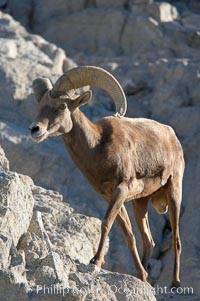
Desert bighorn sheep, male ram. The desert bighorn sheep occupies dry, rocky mountain ranges in the Mojave and Sonoran desert regions of California, Nevada and Mexico. The desert bighorn sheep is highly endangered in the United States, having a population of only about 4000 individuals, and is under survival pressure due to habitat loss, disease, over-hunting, competition with livestock, and human encroachment.
Species: Desert bighorn sheep, Ovis canadensis nelsoni
Image ID: 14651
Species: Desert bighorn sheep, Ovis canadensis nelsoni
Image ID: 14651
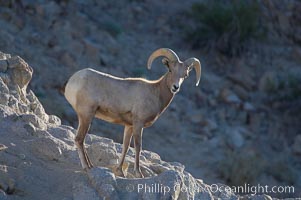
Desert bighorn sheep, young/immature male ram. The desert bighorn sheep occupies dry, rocky mountain ranges in the Mojave and Sonoran desert regions of California, Nevada and Mexico. The desert bighorn sheep is highly endangered in the United States, having a population of only about 4000 individuals, and is under survival pressure due to habitat loss, disease, over-hunting, competition with livestock, and human encroachment.
Species: Desert bighorn sheep, Ovis canadensis nelsoni
Image ID: 14652
Species: Desert bighorn sheep, Ovis canadensis nelsoni
Image ID: 14652
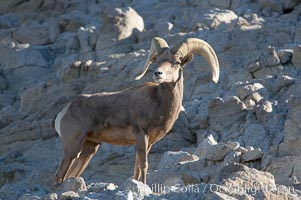
Desert bighorn sheep, male ram. The desert bighorn sheep occupies dry, rocky mountain ranges in the Mojave and Sonoran desert regions of California, Nevada and Mexico. The desert bighorn sheep is highly endangered in the United States, having a population of only about 4000 individuals, and is under survival pressure due to habitat loss, disease, over-hunting, competition with livestock, and human encroachment.
Species: Desert bighorn sheep, Ovis canadensis nelsoni
Image ID: 14653
Species: Desert bighorn sheep, Ovis canadensis nelsoni
Image ID: 14653
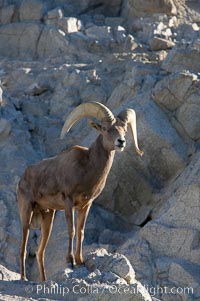
Desert bighorn sheep, male ram. The desert bighorn sheep occupies dry, rocky mountain ranges in the Mojave and Sonoran desert regions of California, Nevada and Mexico. The desert bighorn sheep is highly endangered in the United States, having a population of only about 4000 individuals, and is under survival pressure due to habitat loss, disease, over-hunting, competition with livestock, and human encroachment.
Species: Desert bighorn sheep, Ovis canadensis nelsoni
Image ID: 14654
Species: Desert bighorn sheep, Ovis canadensis nelsoni
Image ID: 14654
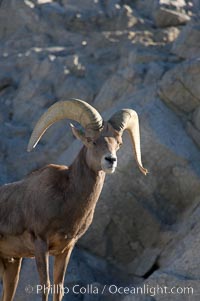
Desert bighorn sheep, male ram. The desert bighorn sheep occupies dry, rocky mountain ranges in the Mojave and Sonoran desert regions of California, Nevada and Mexico. The desert bighorn sheep is highly endangered in the United States, having a population of only about 4000 individuals, and is under survival pressure due to habitat loss, disease, over-hunting, competition with livestock, and human encroachment.
Species: Desert bighorn sheep, Ovis canadensis nelsoni
Image ID: 14655
Species: Desert bighorn sheep, Ovis canadensis nelsoni
Image ID: 14655
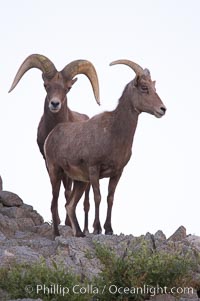
Desert bighorn sheep, male ram and female ewe. The desert bighorn sheep occupies dry, rocky mountain ranges in the Mojave and Sonoran desert regions of California, Nevada and Mexico. The desert bighorn sheep is highly endangered in the United States, having a population of only about 4000 individuals, and is under survival pressure due to habitat loss, disease, over-hunting, competition with livestock, and human encroachment.
Species: Desert bighorn sheep, Ovis canadensis nelsoni
Image ID: 14656
Species: Desert bighorn sheep, Ovis canadensis nelsoni
Image ID: 14656
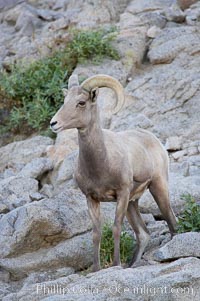
Desert bighorn sheep, young/immature male ram. The desert bighorn sheep occupies dry, rocky mountain ranges in the Mojave and Sonoran desert regions of California, Nevada and Mexico. The desert bighorn sheep is highly endangered in the United States, having a population of only about 4000 individuals, and is under survival pressure due to habitat loss, disease, over-hunting, competition with livestock, and human encroachment.
Species: Desert bighorn sheep, Ovis canadensis nelsoni
Image ID: 14657
Species: Desert bighorn sheep, Ovis canadensis nelsoni
Image ID: 14657
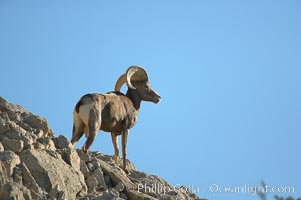
Desert bighorn sheep, male ram. The desert bighorn sheep occupies dry, rocky mountain ranges in the Mojave and Sonoran desert regions of California, Nevada and Mexico. The desert bighorn sheep is highly endangered in the United States, having a population of only about 4000 individuals, and is under survival pressure due to habitat loss, disease, over-hunting, competition with livestock, and human encroachment.
Species: Desert bighorn sheep, Ovis canadensis nelsoni
Image ID: 14658
Species: Desert bighorn sheep, Ovis canadensis nelsoni
Image ID: 14658
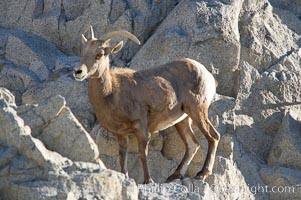
Desert bighorn sheep, female ewe. The desert bighorn sheep occupies dry, rocky mountain ranges in the Mojave and Sonoran desert regions of California, Nevada and Mexico. The desert bighorn sheep is highly endangered in the United States, having a population of only about 4000 individuals, and is under survival pressure due to habitat loss, disease, over-hunting, competition with livestock, and human encroachment.
Species: Desert bighorn sheep, Ovis canadensis nelsoni
Image ID: 14659
Species: Desert bighorn sheep, Ovis canadensis nelsoni
Image ID: 14659
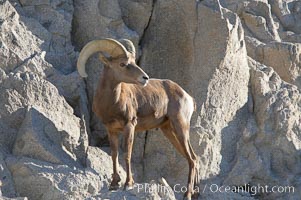
Desert bighorn sheep, male ram. The desert bighorn sheep occupies dry, rocky mountain ranges in the Mojave and Sonoran desert regions of California, Nevada and Mexico. The desert bighorn sheep is highly endangered in the United States, having a population of only about 4000 individuals, and is under survival pressure due to habitat loss, disease, over-hunting, competition with livestock, and human encroachment.
Species: Desert bighorn sheep, Ovis canadensis nelsoni
Image ID: 14660
Species: Desert bighorn sheep, Ovis canadensis nelsoni
Image ID: 14660
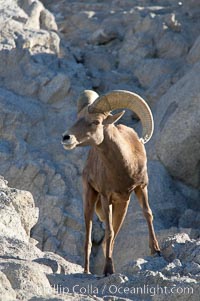
Desert bighorn sheep, male ram. The desert bighorn sheep occupies dry, rocky mountain ranges in the Mojave and Sonoran desert regions of California, Nevada and Mexico. The desert bighorn sheep is highly endangered in the United States, having a population of only about 4000 individuals, and is under survival pressure due to habitat loss, disease, over-hunting, competition with livestock, and human encroachment.
Species: Desert bighorn sheep, Ovis canadensis nelsoni
Image ID: 14661
Species: Desert bighorn sheep, Ovis canadensis nelsoni
Image ID: 14661

Desert bighorn sheep, male ram. The desert bighorn sheep occupies dry, rocky mountain ranges in the Mojave and Sonoran desert regions of California, Nevada and Mexico. The desert bighorn sheep is highly endangered in the United States, having a population of only about 4000 individuals, and is under survival pressure due to habitat loss, disease, over-hunting, competition with livestock, and human encroachment.
Species: Desert bighorn sheep, Ovis canadensis nelsoni
Image ID: 14662
Species: Desert bighorn sheep, Ovis canadensis nelsoni
Image ID: 14662
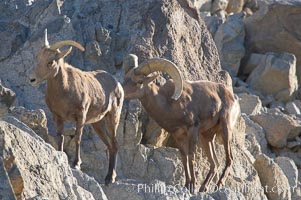
Desert bighorn sheep, male ram and female ewe. The desert bighorn sheep occupies dry, rocky mountain ranges in the Mojave and Sonoran desert regions of California, Nevada and Mexico. The desert bighorn sheep is highly endangered in the United States, having a population of only about 4000 individuals, and is under survival pressure due to habitat loss, disease, over-hunting, competition with livestock, and human encroachment.
Species: Desert bighorn sheep, Ovis canadensis nelsoni
Image ID: 14663
Species: Desert bighorn sheep, Ovis canadensis nelsoni
Image ID: 14663
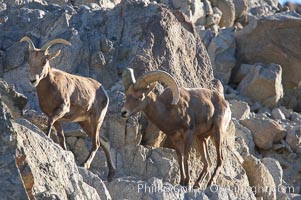
Desert bighorn sheep, male ram and female ewe. The desert bighorn sheep occupies dry, rocky mountain ranges in the Mojave and Sonoran desert regions of California, Nevada and Mexico. The desert bighorn sheep is highly endangered in the United States, having a population of only about 4000 individuals, and is under survival pressure due to habitat loss, disease, over-hunting, competition with livestock, and human encroachment.
Species: Desert bighorn sheep, Ovis canadensis nelsoni
Image ID: 14664
Species: Desert bighorn sheep, Ovis canadensis nelsoni
Image ID: 14664
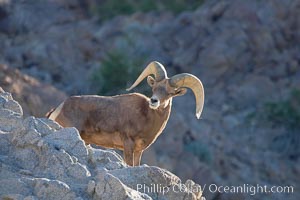
Desert bighorn sheep, male ram. The desert bighorn sheep occupies dry, rocky mountain ranges in the Mojave and Sonoran desert regions of California, Nevada and Mexico. The desert bighorn sheep is highly endangered in the United States, having a population of only about 4000 individuals, and is under survival pressure due to habitat loss, disease, over-hunting, competition with livestock, and human encroachment.
Species: Desert bighorn sheep, Ovis canadensis nelsoni
Image ID: 14665
Species: Desert bighorn sheep, Ovis canadensis nelsoni
Image ID: 14665
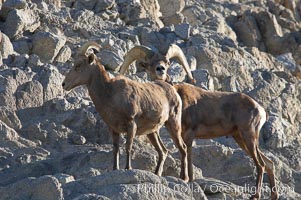
Desert bighorn sheep, male ram and female ewe. The desert bighorn sheep occupies dry, rocky mountain ranges in the Mojave and Sonoran desert regions of California, Nevada and Mexico. The desert bighorn sheep is highly endangered in the United States, having a population of only about 4000 individuals, and is under survival pressure due to habitat loss, disease, over-hunting, competition with livestock, and human encroachment.
Species: Desert bighorn sheep, Ovis canadensis nelsoni
Image ID: 14666
Species: Desert bighorn sheep, Ovis canadensis nelsoni
Image ID: 14666
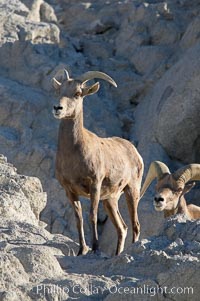
Desert bighorn sheep, female ewe. The desert bighorn sheep occupies dry, rocky mountain ranges in the Mojave and Sonoran desert regions of California, Nevada and Mexico. The desert bighorn sheep is highly endangered in the United States, having a population of only about 4000 individuals, and is under survival pressure due to habitat loss, disease, over-hunting, competition with livestock, and human encroachment.
Species: Desert bighorn sheep, Ovis canadensis nelsoni
Image ID: 14667
Species: Desert bighorn sheep, Ovis canadensis nelsoni
Image ID: 14667
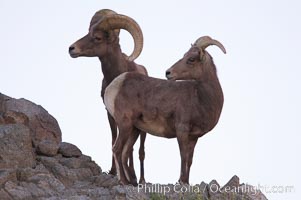
Desert bighorn sheep, male ram and female ewe. The desert bighorn sheep occupies dry, rocky mountain ranges in the Mojave and Sonoran desert regions of California, Nevada and Mexico. The desert bighorn sheep is highly endangered in the United States, having a population of only about 4000 individuals, and is under survival pressure due to habitat loss, disease, over-hunting, competition with livestock, and human encroachment.
Species: Desert bighorn sheep, Ovis canadensis nelsoni
Image ID: 14668
Species: Desert bighorn sheep, Ovis canadensis nelsoni
Image ID: 14668
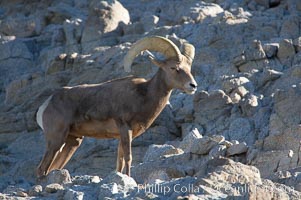
Desert bighorn sheep, male ram. The desert bighorn sheep occupies dry, rocky mountain ranges in the Mojave and Sonoran desert regions of California, Nevada and Mexico. The desert bighorn sheep is highly endangered in the United States, having a population of only about 4000 individuals, and is under survival pressure due to habitat loss, disease, over-hunting, competition with livestock, and human encroachment.
Species: Desert bighorn sheep, Ovis canadensis nelsoni
Image ID: 14669
Species: Desert bighorn sheep, Ovis canadensis nelsoni
Image ID: 14669
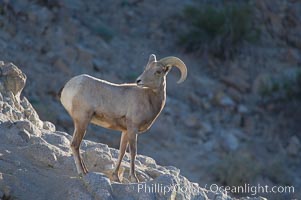
Desert bighorn sheep, young/immature male ram. The desert bighorn sheep occupies dry, rocky mountain ranges in the Mojave and Sonoran desert regions of California, Nevada and Mexico. The desert bighorn sheep is highly endangered in the United States, having a population of only about 4000 individuals, and is under survival pressure due to habitat loss, disease, over-hunting, competition with livestock, and human encroachment.
Species: Desert bighorn sheep, Ovis canadensis nelsoni
Image ID: 14670
Species: Desert bighorn sheep, Ovis canadensis nelsoni
Image ID: 14670
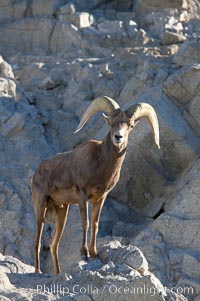
Desert bighorn sheep, male ram. The desert bighorn sheep occupies dry, rocky mountain ranges in the Mojave and Sonoran desert regions of California, Nevada and Mexico. The desert bighorn sheep is highly endangered in the United States, having a population of only about 4000 individuals, and is under survival pressure due to habitat loss, disease, over-hunting, competition with livestock, and human encroachment.
Species: Desert bighorn sheep, Ovis canadensis nelsoni
Image ID: 14671
Species: Desert bighorn sheep, Ovis canadensis nelsoni
Image ID: 14671




